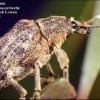Abstract
El árbol melaleuca es una planta leñosa invasiva, nativa de Australia, Nueva Guinea, y las Islas Salomón. La melaleuca, conocida también como el árbol de corteza de papel, cajeput, punk tree, o árbol de cepillo blanco, fue introducida en Florida al final del siglo 19 pero aparentemente no se naturalizó hasta el año 1906. La melaleuca fue sembrada extensivamente como un árbol ornamental, y eventualmente invadió los humedales con y sin bosques en el sur de Florida formando monocultivos densos.
This 5-page fact sheet is the Spanish-language version of EENY211/IN368: Melaleuca Snout Beetle, Melaleuca Weevil (unofficial common names), Oxyops vitiosa (Pascoe) (Insecta: Coleoptera: Curculionidae), written by J.P. Cuda, S.A. Wineriter, G.R. Buckingham, T.D. Center, and K.T. Gioeli, and published by the UF Department of Entomology and Nematology, December 2013.
References
Balciunas JK, Burrows DW, Purcell MF. 1994. Field and laboratory host ranges of the Australian weevil, Oxyops vitiosa (Coleoptera: Curculionidae), a potential biological control agent for the paperbark tree, Melaleuca quinquenervia. Biological Control 4: 351-360. https://doi.org/10.1006/bcon.1994.1044
Center TD. et al. 2000. Field colonization of the melaleuca snout beetle (Oxyops vitiosa) in south Florida. Biological Control 19: 112-123. https://doi.org/10.1006/bcon.2000.0856
Cuda JP, Wineriter SA, Buckingham GR, Center TD, Gioeli KT. (February 2006.) Classical biological control of weeds with insects: melaleuca weevil. EDIS. http://edis.ifas.ufl.edu/IN172 (11 June 2009).
Langeland KA, Burks KC. 1998. Identification & biology of non-native plants in Florida's natural areas. University of Florida, Gainesville, FL.
Purcell MF, Balciunas JK. 1994. Life history and distribution of the Australian weevil, Oxyops vitiosa (Coleoptera: Curculionidae), a potential biological control agent for Melaleuca quinquenervia (Myrtaceae). Annals of the Entomological Society of America 87: 867-873. https://doi.org/10.1093/aesa/87.6.867
Wheeler GS. 2000. Sequestration of Melaleuca quinquenervia defensive chemistry by Oxyops vitiosa and its relevance to biological control of weeds, p. 431. In Spencer, N.R. (ed.), Proceedings of the X International Symposium of Biological Control of Weeds, 4-14 July 1999. Montana State University, Bozeman, MT.
Wineriter S, Buckingham GR. 1997. Love at first bite - introducing the Australian melaleuca weevil. Aquatics 19: 10-12.

